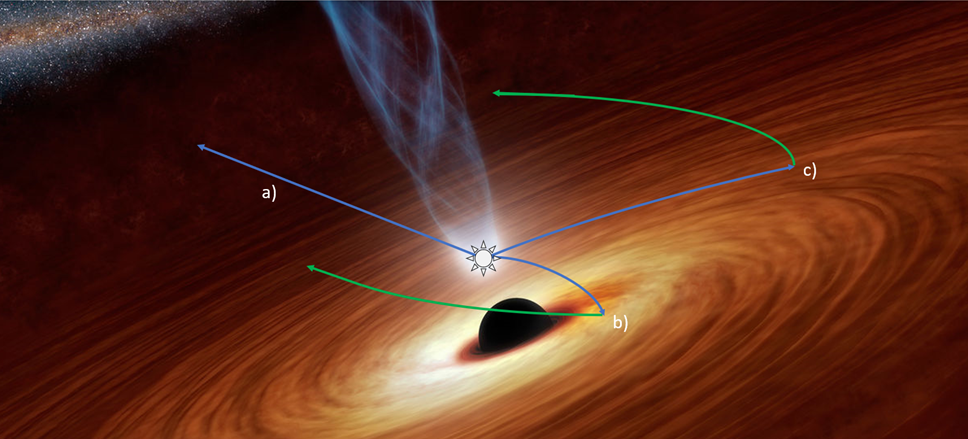Active black holes are surrounded by disks of material and can spew powerful jets. These jets, in turn, can release powerful X-rays. And some of those X-rays will shine downwards towards the black hole and disk. In the disk they can get reflected, creating an echo that astronomers call X-ray reverberation. Such a signal can be used to do some pretty amazing science.
Basically, astronomers are looking at the direct photons emitted by the jet and then looking at how the same light is reflected off the disk. This reverberation doesn’t happen all at the same time because the speed of light is finite. So the reflection will start in the innermost part of the disk, and the signal will ripple outwards as the X-rays from the jet need more time to reach the outer parts of the accretion disk.
“Think of it as a lamppost suspended some distance above the black hole. This lamppost flashes and sends photons out in all directions. Those directly emitted ones will reach us before the ones that bounce off the disc to reach us. This is just due to a different path length,” researcher Dr Patrick O’Neill, from the University of Newcastle, told IFLScience.
“But the disc is not itself a single point, it’s actually got some width to it. So not only is this signal lagging behind the direct photons, they are lagging behind as a function of how far it needs to travel to the disc to be reflected.”
The approach is a way to independently measure the mass and the distance of the black hole and it is not affected by the dusty regions in the center of galaxies, as X-rays fly right through them without being absorbed. The technique was tested successfully on Cygnus X-1, the first X-ray source to be recognized as a black hole.

The X-rays from the jet can reach us directly or be reflected off the disk on paths of different lengths.
Image credit: Patrick O’Neill. Background image: NASA/JPL-Caltech
There are two exciting things that this can be used for. A lot of galactic black holes are found above the planets of the Milky Way, as it is easier to spot them where it is not crowded, similar to the oldest stars. But the black holes that are there are the lighter ones, those that were given a kick by companion stars going supernova. Heavier black holes are to be found around the center of the Milky Way and by looking at these echoes, the team hopes to find them.
And stellar-sized black holes do not only exist in the Milky Way. The ability to measure distance and mass, without having to worry about the dust in the way, is also appealing for the study of supermassive black holes at the center of distant galaxies.
“This can be applied to supermassive black holes really, really far away and we can use that to probe the expansion of the universe in a different way,” Dr O’Neill continued.
There is currently a major tension in the estimates for the expansion rate of the universe. If you use the cosmic microwave background (CMB), the furthest light that can be observed in the universe, you get one number. If you use supernovae as standard candles to measure the distance of much closer – but still distant – galaxies, you get another number.
“This is a new set of standard candles that we can use to probe the Hubble constant that doesn’t rely on supernovae or temperature fluctuation from the CMB,” Dr O’Neill told IFLScience.
The research was presented at the National Astronomical Meeting 2023.
Source Link: Black Hole Echoes Could Help Resolve Tension Around How Fast The Universe Is Expanding